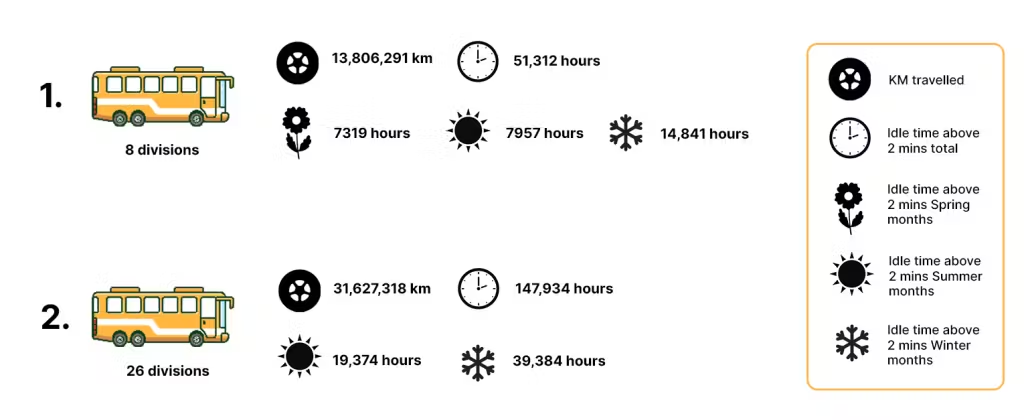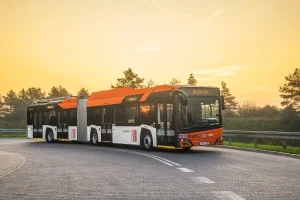II jakten på mer bærekraftig og kostnadseffektiv transport fremstår håndtering av tomgangskjøring som en kritisk, men ofte oversett, strategi. Tomgangskjøring, perioden når kjøretøyene har motorene i gang uten å være i bevegelse, bidrar betydelig til unødvendig drivstoffforbruk og økte utslipp. Denne artikkelen ser på konsekvensene av tomgangskjøring og utforsker strategier for å minimere den, og dermed redusere utslippene og senke driftskostnadene.

Store dieselbusser og lastebiler er viktige deler av byens infrastruktur, som støtter handel og legger til rette for mobilitet. I mange tilfeller er tomgangskjøring uunngåelig, for eksempel når man står fast i trafikken, eller for busser, når de stopper på bussholdeplasser for å plukke opp eller sette av passasjerer.
Imidlertid, når kjøretøy står stille unødvendig, kan de slippe ut enda mer klimagasser, inkludert karbondioksid (CO2), nitrogenoksider (NOx) og partikler, enn nødvendig. Disse utslippene bidrar til luftforurensning, noe som utgjør helsefare for befolkningen og forringer miljøkvaliteten.
For mange transportfirmaer er mengden utslipp de produserer en nøkkelstatistikk de måler, noe som betyr at unødvendig tomgangskjøring har negativ innvirkning på resultatene deres.
Den økonomiske skaden av tomgangskjøring
I tillegg til miljømessige bekymringer representerer tomgangskjøring en betydelig økonomisk byrde for transportselskaper. Drivstoff er, for mange transportselskaper, den største kostnaden de har i driften, og med tanke på at de fleste transportselskaper ikke har store marginer, er det et problem å kaste bort drivstoff. Med stigende kostnader for diesel er det også avgjørende å finne måter å redusere kostnader på.
For en flåte med 50 kjøretøy, er selv 5 minutter med tomgangskjøring per dag per kjøretøy en betydelig kostnad. For mange transportselskaper betyr det å redusere tomgangskjøring en stor økonomisk besparelse, penger som kan brukes på andre områder i driften.
Hva sier statistikken?
Vi sammenlignet to busselskaper i Norge fra starten av året (januar) til slutten av året (desember). Vi ønsket å forstå hvor mye tomgangskjøring som skjer i disse kjøretøyene, og hvilken, om noen, forskjell årstidene gjør.
Busselskap 1, med 8 divisjoner, kjørte totalt 13,806,291 km gjennom hele året. Innenfor disse reisene var summen av tomgangskjøring (over to minutter) 51,312 timer. Busselskap 2, med 26 divisjoner, kjørte totalt 31,627,318 km gjennom hele året. Innenfor disse reisene var summen av tomgangskjøring (over to minutter) 147,934 timer.
Men hvordan sammenlignes disse statistikkene gjennom året?
For busselskap 1 hadde vår- og sommermånedene nesten halvparten så mange timer med tomgangskjøring (7,319 i Q2 og 7,957 timer i Q3) som vintermånedene januar, februar og mars (14,841 timer).
Basert på dette kan vi se at i de varmere månedene om våren og sommeren var tomgangskjøringen betydelig lavere enn i vintermånedene. Dette kan skyldes oppvarming av bussene før og under en reise i det kalde norske klimaet.
For busselskap 2 var sommermånedene juli, august og september (19,374 timer) rundt 20,000 timer mindre enn vintermånedene januar, februar og mars (39,384 timer). Basert på dette kan vi også se at de varmere månedene involverer mye mindre tomgangskjøring enn vintermånedene.
Hvordan kan tomgangskjøring reduseres?
Teknologiske løsninger
Sanntidssporing og flåtestyringssystemer som Tenix Bus kan overvåke kjøretøyoperasjoner, identifisere hvor tomgangskjøring skjer og gjøre det mulig for operatører å iverksette korrigerende tiltak. Operatørene vil være i stand til å identifisere nøyaktige steder og ruter hvor tomgangskjøring forekommer mye, hvilke sjåfører som ofte står stille, og deres gjennomsnittlige kjøring på tomgang.
Ved å få denne oversikten fjernes manuelle metoder for sporing av tomgangskjøring, og du kan holde all informasjon og data på ett sted for enkel analyse.
Politikk og regulering
Implementering og håndheving av reguleringer for reduksjon av kjøring på tomgang kan tvinge operatører til å minimere tomgangskjøring. Flere byer og land har innført bøter for å overskride tillatte tomgangskjørings-perioder, men dette gjelder hovedsakelig personbiler, snarere enn store transportkjøretøy. Med fokus på mer bærekraftig transport må mange transportselskaper nå rapportere om sine utslipp, noe som skaper et insentiv til å redusere tomgangskjøring og unødvendige utslipp.
Atferdsendringer
Å utdanne sjåfører om konsekvensene av tomgangskjøring og strategier for å redusere kjøring på tomgang kan føre til betydelige forbedringer. Ved å kombinere dette trinnet med nummer 1, kan du forsterke veiledningen din med data. For eksempel, kanskje en sjåfør lar motoren gå i depotet i lang tid før de starter ruten sin, og du kan se dette i dataene. Sjåføren kan få vist dette og bli rådet til å starte motoren først når de er klare til å begynne å kjøre. Enkle endringer i atferd kan ha stor innvirkning.
Å redusere tomgangskjøring i store transportkjøretøy er et avgjørende skritt mot å oppnå grønnere og mer effektive transportløsninger. Gjennom en kombinasjon av teknologi, politikk og atferdsendringer er det mulig å kutte utslipp betydelig og redusere driftskostnader. Etter hvert som byene fortsetter å vokse og søker bærekraftige løsninger, tilbyr håndtering av tomgangskjøring en klar vei til en renere og mer kostnadseffektiv fremtid.


